Starved Rock State Park
- January 5, 2024
- 0 comment
Located along the banks of the Illinois River, Starved Rock State Park stands as a breathtaking testament to the natural beauty that graces the American Midwest. Located just southwest of Chicago, this enchanting park spans over 2,600 acres and boasts an array of awe-inspiring canyons, towering cliffs, and lush woodlands. What sets Starved Rock apart is its unique geological formations, carved over centuries by the powerful forces of water and ice.
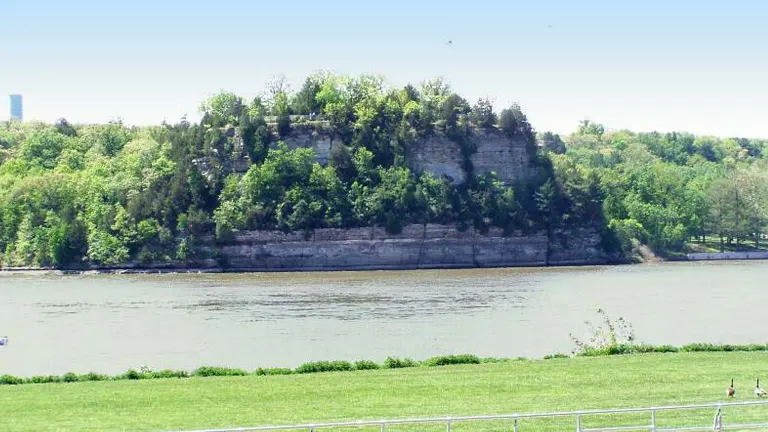
Visitors are greeted by the majestic Starved Rock itself, a sandstone butte that rises dramatically from the riverbank, offering panoramic views of the surrounding landscape. With 13 miles of well-maintained hiking trails, each leading to cascading waterfalls, hidden coves, and scenic overlooks, the park provides an immersive experience for nature enthusiasts and adventure seekers alike. Rich in history and natural wonders, Starved Rock State Park beckons explorers to discover the unparalleled beauty and serenity that define this Midwest gem.
Characterizing Features of the Starved Rock State Park
- Unique Geological Formations: Starved Rock State Park is renowned for its distinctive geological features, prominently showcasing the St. Peter Sandstone outcrops. This exposed sandstone, typically buried, is revealed due to an anticline—a convex fold in the underlying strata. The result is a mesmerizing landscape of canyons and cliffs, shaped by the forces of the Kankakee Torrent approximately 14,000–19,000 years ago. The porous and easily workable nature of the sandstone adds to the park’s geological significance, offering visitors a glimpse into the dynamic history of the region.
- Historical Significance: Beyond its geological allure, Starved Rock is steeped in history. The site was once home to Native American communities, notably the Kaskaskia tribe, and later became a focal point for European exploration. French explorers Louis Jolliet and Jacques Marquette established Fort St. Louis on the large sandstone butte in 1683. The park’s name itself derives from a somber legend involving a Native American tribe seeking refuge on the rock during a siege, ultimately succumbing to starvation. The remnants of this history, including the Civilian Conservation Corps-built facilities from the 1930s, contribute to Starved Rock’s status as a National Historic Landmark.
- Flora and Fauna Diversity: Starved Rock State Park is a haven for biodiversity, boasting approximately 150 types of plants. The sandstone cliffs are adorned with white pine, Canada yew, and northern white cedar, creating a unique ecosystem. The park’s proximity to the Illinois River also supports various game fish, such as catfish, sauger, and carp. The diverse flora includes notable species like harebell, reindeer lichen, and Indian cucumber root. This rich ecological tapestry offers nature enthusiasts a fascinating exploration of both plant and animal life within the park.
- Recreational Activities: With over 13 miles of well-maintained hiking trails, Starved Rock provides ample opportunities for outdoor recreation. Designated as a National Recreation Trail, the trail system leads visitors through 18 deep canyons, each with its own unique charm. Scenic viewpoints like Lover’s Leap Overlook and Eagle Cliff Overlook offer panoramic vistas of the surrounding landscape. The park caters to a range of activities, including camping, boating, and fishing. During winter, the waterfalls transform into enchanting ice falls, setting the stage for activities such as ice skating, tobogganing, and cross-country skiing.
- Seasonal Attractions: Starved Rock State Park offers a dynamic experience throughout the seasons. Winter visitors can witness bald eagles fishing near the Starved Rock Dam and enjoy ice falls at the waterfalls. The park’s Visitor Center lends binoculars for eagle-watching, enhancing the winter birding experience. Spring and summer unveil a vibrant display of flora, with wildflowers dotting the canyons. Fall brings a spectacular tapestry of autumn colors, making it an ideal time for hiking and appreciating the natural beauty. The seasonal transformations add to the allure of Starved Rock, ensuring that each visit offers a unique and captivating experience.
History
Starved Rock State Park boasts a rich tapestry of history that echoes through the canyons and cliffs along the Illinois River. Before European contact, the area was inhabited by Native American communities, notably the Kaskaskia tribe, who thrived in the region. The park’s name finds its roots in a tragic legend, where, in the late 18th century, a group of Illiniwek sought refuge on the towering sandstone butte during a siege by the Ottawa and Potawatomi. The relentless pursuit resulted in starvation, giving rise to the name “Starved Rock.” European exploration unfolded as Louis Jolliet and Jacques Marquette first set foot in the region in 1683, later establishing Fort St. Louis atop the butte. In the late 19th century, the park’s surroundings transformed into a vacation resort, a testament to its allure.

In 1911, the State of Illinois stepped in, acquiring the site and preserving its natural splendor for future generations. The park’s historic significance is underscored by the structures built by the Civilian Conservation Corps in the 1930s, earning it a spot on the National Register of Historic Places in 1960. Today, Starved Rock State Park stands not only as a testament to geological forces but also as a living chronicle of the Native American heritage and European exploration that shaped its captivating narrative.
Importance in Conservation and Recreation of Starved Rock State Park
Starved Rock State Park holds a dual significance as a bastion of conservation and a haven for recreation, blending the preservation of natural ecosystems with outdoor enjoyment. On the conservation front, the park’s 2,630 acres encompass a diverse range of flora and fauna, showcasing over 150 plant species and providing a habitat for various wildlife, including game fish along the Illinois River. The preservation of unique geological formations, such as the St. Peter Sandstone outcrops, adds to its ecological importance.
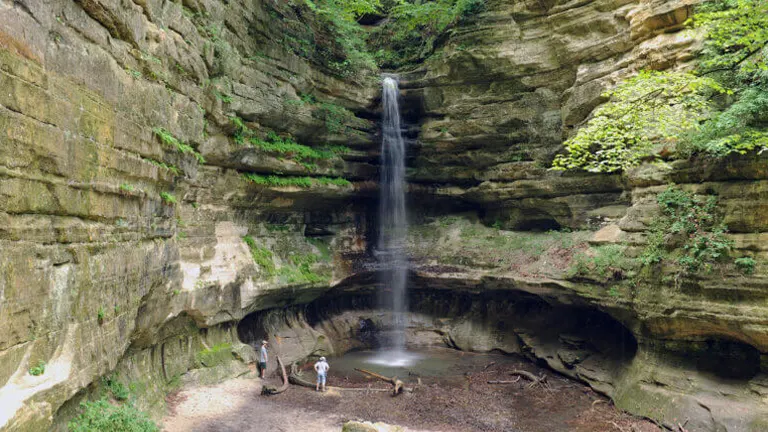
Simultaneously, Starved Rock is a playground for outdoor enthusiasts, offering over 13 miles of hiking trails, designated as a National Recreation Trail, and recreational activities like camping, boating, and fishing. The careful balance between conservation efforts and recreational offerings underscores the park’s commitment to environmental stewardship, ensuring that visitors can immerse themselves in the natural beauty of the region while contributing to its long-term preservation. In doing so, Starved Rock State Park stands as a shining example of the harmonious coexistence of conservation and recreation within our natural landscapes.
Unique Location of Starved Rock State Park
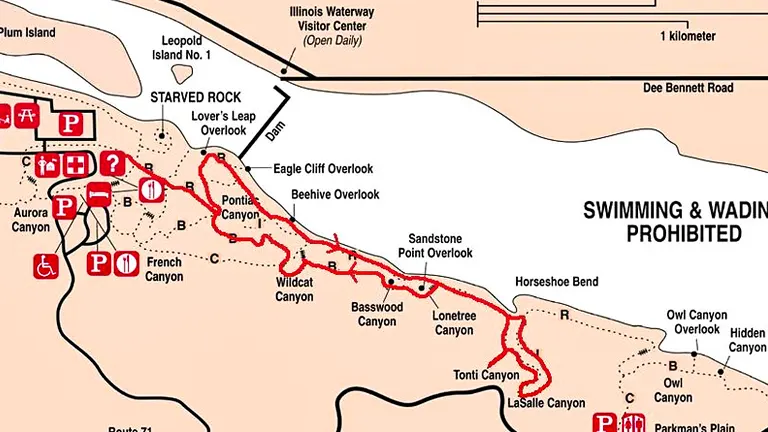
Starved Rock State Park occupies a truly remarkable location along the meandering course of the Illinois River, bestowing upon it a unique and captivating setting. Situated just southeast of Utica in LaSalle County, Illinois, the park’s 2,630 acres unfold along the south bank of the river, creating a picturesque panorama of geological wonders and lush woodlands. Its strategic position within the American Midwest grants visitors a remarkable escape into nature’s embrace, conveniently accessible from major urban centers like Chicago. The park’s distinctiveness lies not only in its geological features, like the signature St. Peter Sandstone outcrops and canyons carved by the ancient Kankakee Torrent but also in its role as a sanctuary that seamlessly marries natural splendor with accessibility. This unique location ensures that Starved Rock State Park stands as a jewel in the heart of the Midwest, offering a tranquil retreat and a testament to the diverse and awe-inspiring landscapes that grace the region.
Diverse Vegetation and Plant Species in Starved Rock State Park
- White Pine (Pinus strobus): Towering white pines grace the sandstone cliffs of Starved Rock State Park, adding to the diverse vegetation. This species, more commonly found further north, finds a unique home within the park, contributing to its distinctive ecological character.
- Canada Yew (Taxus canadensis): The presence of Canada Yew further enriches the flora of Starved Rock. Flourishing in the cooler microclimates of the canyons and cliffs, this evergreen shrub contributes to the park’s botanical diversity, creating pockets of greenery amid the geological formations.
- Northern White Cedar (Thuja occidentalis): Found alongside the white pine and Canada yew, the northern white cedar adds another layer to the park’s unique plant composition. Thriving in the park’s specific environmental conditions, these cedars contribute to the park’s visual appeal and ecological balance.
- Harebell (Campanula rotundifolia): In the cooler surfaces of the canyons and cliffs, delicate harebells sway, adding a touch of floral elegance to the landscape. These hardy perennials showcase the adaptability of plant life in the park’s varied microenvironments.
- Reindeer Lichen (Cladonia): Decorating the surfaces of the canyons and cliffs, reindeer lichen is a botanical gem of Starved Rock. This non-vascular plant thrives in the unique conditions created by the sandstone formations, contributing to the park’s overall ecological tapestry.
- Indian Cucumber Root (Medeola virginiana): A rare lily in Illinois, the Indian cucumber root has been identified within the park, adding to its botanical significance. The discovery of this plant highlights the park’s role as a refuge for plant species that may be less common in the surrounding region.
- Lady’s Slipper Orchid (Cypripedium): Among the diverse plant life, the lady’s slipper orchid graces the park with its elusive beauty. Vulnerable to invasive species and habitat changes, its presence emphasizes the delicate balance that the park strives to maintain in its conservation efforts.
- Liverwort (Marchantiophyta): On the sandstone surfaces throughout Starved Rock State Park, liverworts find a home. These non-vascular plants contribute to the park’s botanical diversity, showcasing the adaptability of life in this unique geological environment.
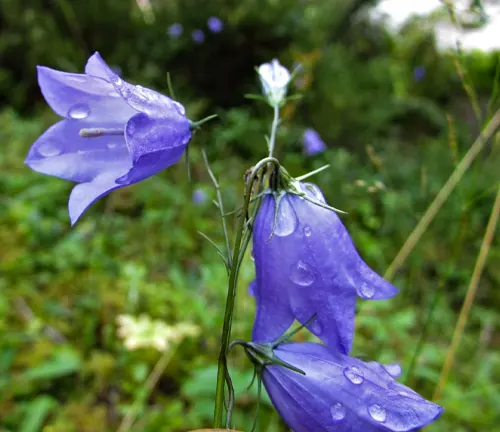
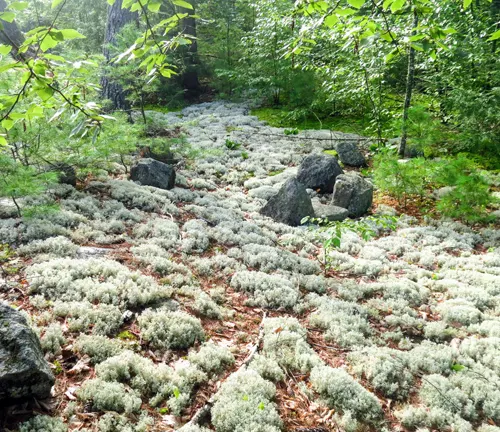
The diverse vegetation and plant species within Starved Rock State Park underscore its ecological importance and the intricate interplay between geological formations and the rich tapestry of plant life. Each species contributes to the park’s visual allure and ecological resilience, making it a haven for botanists and nature enthusiasts alike.
Fauna
- Eastern Massasauga (Sistrurus catenatus catenatus): The Eastern Massasauga, a venomous rattlesnake species, is found within the confines of Starved Rock State Park. This small, secretive rattlesnake plays a crucial role in the park’s ecosystem, participating in the natural balance of predator-prey relationships.
- Timber Rattlesnake (Crotalus horridus): Another rattlesnake species present in the park is the Timber Rattlesnake. Though sightings are rare due to their elusive nature, their presence emphasizes the importance of the park as a habitat for diverse reptile species.
- Bald Eagles (Haliaeetus leucocephalus): Starved Rock State Park serves as a winter refuge for Bald Eagles. Haliaeetus leucocephalus, with their iconic white heads and tails, can be observed along the Illinois River. Their presence highlights the park’s significance in providing a wintering ground for these majestic birds.
- White-Tailed Deer (Odocoileus virginianus): The woodlands and meadows of Starved Rock host a population of White-Tailed Deer. Odocoileus virginianus, known for their distinctive tails, are a common sight for visitors exploring the park’s trail system.
- Gray Fox (Urocyon cinereoargenteus): The elusive Gray Fox, Urocyon cinereoargenteus, is among the park’s native carnivores. Preferring wooded habitats, these foxes contribute to the park’s biodiversity, playing a role in the delicate balance of predator and prey populations.
- Common Raccoon (Procyon lotor): Procyon lotor, the Common Raccoon, thrives in the diverse ecosystems of Starved Rock. These nocturnal mammals are often encountered along trails, showcasing their adaptability to human-inhabited areas within the park.
- Eastern Screech Owl (Megascops asio): The Eastern Screech Owl, Megascops asio, is a resident bird of prey within the park. Their distinctive calls and nocturnal habits make them a fascinating addition to the park’s avian diversity.
- Eastern Cottontail Rabbit (Sylvilagus floridanus): Sylvilagus floridanus, the Eastern Cottontail Rabbit, is a common sight in the meadows and grassy areas of Starved Rock. Their presence contributes to the park’s diverse herbivore population.
- River Otter (Lontra canadensis): Lontra canadensis, the River Otter, is among the aquatic mammals that inhabit the waterways of the park. Their playful nature and sleek presence underscore the health of the park’s aquatic ecosystems.
- Common Gartersnake (Thamnophis sirtalis): Thamnophis sirtalis, the Common Gartersnake, is frequently encountered in various habitats within Starved Rock State Park. These non-venomous snakes play a vital role in controlling small mammal and amphibian populations.


The diverse fauna within Starved Rock State Park, ranging from reptiles and birds to mammals and amphibians, contributes to the park’s ecological vibrancy. Conservation efforts aimed at preserving the natural habitats and maintaining a delicate balance among these species underscore the importance of this Illinois treasure.
Attractions in Starved Rock State Park
1. Starved Rock

The eponymous Starved Rock, a sandstone butte rising dramatically from the Illinois River, serves as the focal point and symbol of the park’s geological grandeur. Formed over millennia by the forces of the Kankakee Torrent, this towering rock formation offers panoramic views of the surrounding landscape and stands as a testament to the region’s ancient geological history. Accessible by well-maintained trails, reaching the summit of Starved Rock is a rewarding experience, providing visitors with awe-inspiring vistas.
2. Waterfalls and Canyons
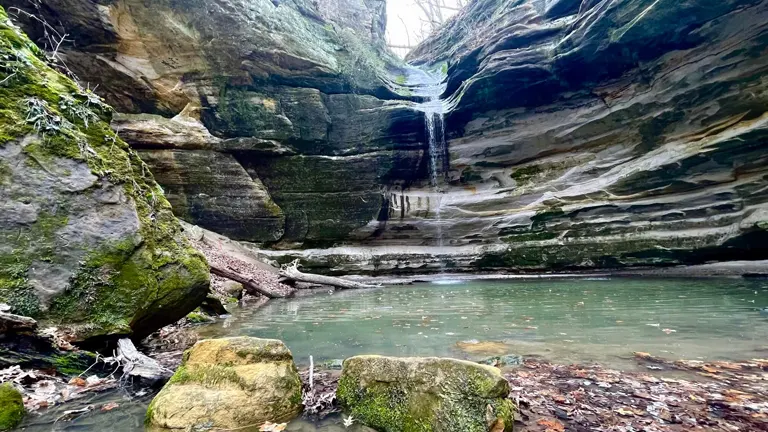
Starved Rock State Park is renowned for its 18 canyons, each uniquely carved by streams flowing over the exposed St. Peter Sandstone. The park features captivating waterfalls that cascade down these canyons, creating a symphony of nature’s beauty. From the scenic LaSalle Canyon to the dramatic St. Louis Canyon, the waterfalls offer a serene backdrop for hikers and nature enthusiasts, especially during the spring thaw and after heavy rains when they are at their most majestic.
3. Wildlife Watching

The park’s diverse ecosystems provide an excellent opportunity for wildlife observation. From white-tailed deer grazing in meadows to bald eagles soaring along the Illinois River, visitors can witness a rich array of fauna. Birdwatchers, in particular, are drawn to the park during winter to observe the majestic bald eagles that congregate in the area.
4. Hiking Trails
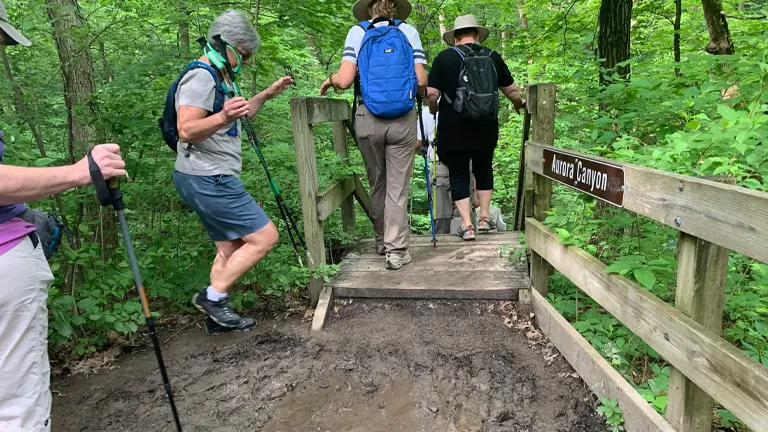
Starved Rock State Park boasts over 13 miles of well-marked and scenic hiking trails, making it a paradise for outdoor enthusiasts. Whether navigating the meandering paths along the Illinois River or exploring the deep canyons, each trail offers a unique perspective of the park’s natural beauty. The park’s trail system caters to various skill levels, from casual strollers to avid hikers seeking a more challenging adventure.
5. Historic Lodge

The historic Starved Rock Lodge, listed on the National Register of Historic Places, adds a touch of charm to the park. Built by the Civilian Conservation Corps in the 1930s, the lodge features rustic architecture and serves as a hub for visitors. Inside, the Great Hall showcases intricate woodwork and a massive stone fireplace, creating a warm and inviting atmosphere.
6. Visitor Center and Interpretive Programs
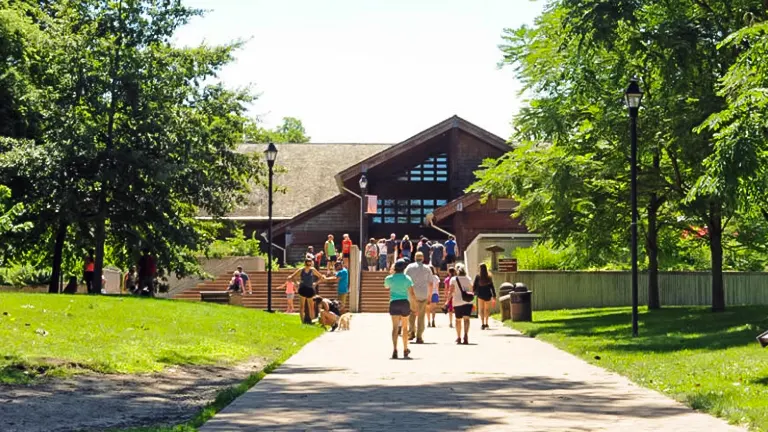
The Visitor Center at Starved Rock State Park provides essential information for visitors, including trail maps and interpretive exhibits about the park’s geology, flora, and fauna. Rangers conduct informative programs and guided hikes, offering a deeper understanding of the park’s natural and cultural history. The center enhances the overall visitor experience by fostering a connection with the park’s unique features.
7. Seasonal Events and Activities
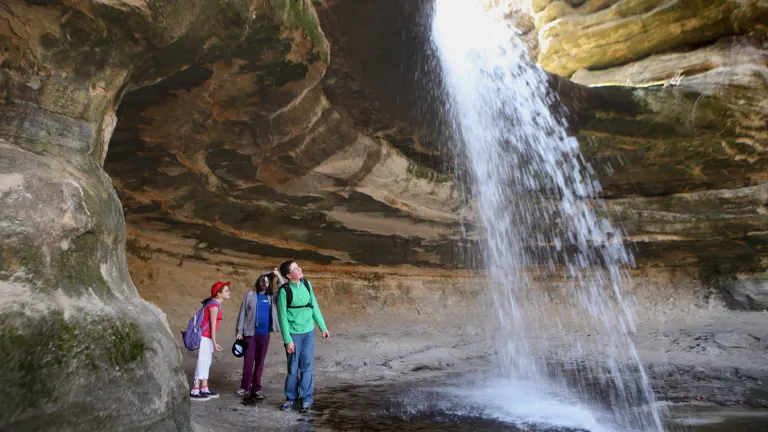
Throughout the year, Starved Rock hosts a variety of seasonal events and activities. From winter eagle-watching excursions to spring wildflower hikes, the park’s calendar is filled with opportunities for immersive experiences. Additionally, during the winter months, frozen waterfalls transform into enchanting ice falls, creating a picturesque backdrop for activities like ice climbing and winter sports.
8. Camping and Recreation
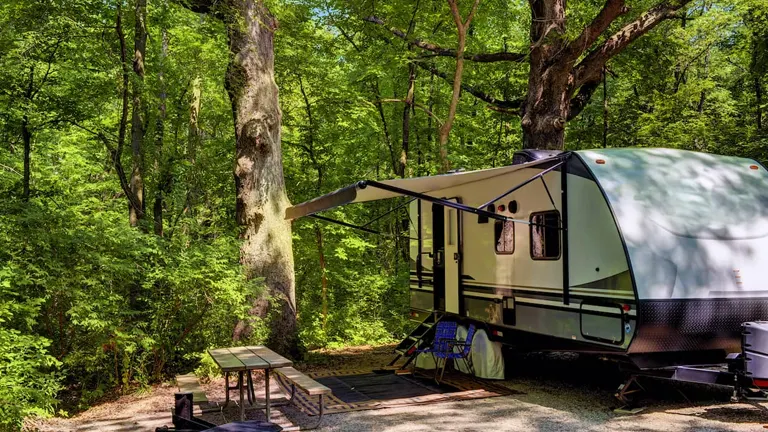
For those seeking a more extended stay, Starved Rock State Park offers camping facilities. With 133 campsites, including some that can be reserved, visitors can immerse themselves in the natural surroundings and extend their exploration of the park. The campgrounds are equipped with amenities to enhance the camping experience, making it an ideal base for further adventures within the park.
Starved Rock State Park’s attractions, ranging from geological wonders to recreational opportunities and historical landmarks, create a dynamic and immersive experience for visitors, ensuring that each trip to the park unfolds a new layer of its natural and cultural richness.
Recreational Activities in the Starved Rock State Park
1. Hiking

Starved Rock State Park boasts an extensive trail system covering over 13 miles, offering a diverse range of hiking experiences. Trails wind through lush woodlands, meander along the Illinois River, and lead to the park’s iconic canyons and waterfalls. Whether visitors are seeking a stroll or a challenging hike, the well-maintained trails cater to varying skill levels, providing an immersive encounter with the park’s natural beauty.
2. Camping

Camping enthusiasts can embrace the tranquility of Starved Rock by staying at one of the park’s 133 campsites. Nestled amidst the scenic surroundings, the campgrounds offer a chance to extend the outdoor experience. Equipped with amenities, including fire pits and picnic tables, the campsites provide a comfortable base for exploring the park and indulging in the sights and sounds of nature.
3. Fishing
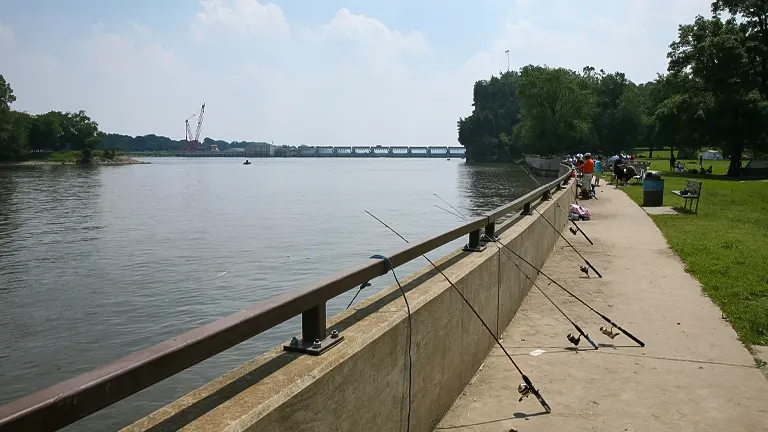
The Illinois River, flowing along the park’s borders, presents an enticing opportunity for fishing enthusiasts. Anglers can cast their lines in search of various game fish, including catfish, bullhead, white bass, sauger, walleye, carp, and crappie. The river’s diverse aquatic ecosystem makes fishing a popular recreational activity, offering both relaxation and the thrill of a potential catch.
5. Bird Watching

Starved Rock State Park is a haven for bird watchers, especially during the winter months when bald eagles gather along the Illinois River. The park’s varied habitats, including woodlands, canyons, and open spaces, attract a diverse avian population. Binoculars in hand, visitors can spot anything from songbirds and raptors to waterfowl, enhancing the overall outdoor experience.
6. Winter Sports

Embracing the winter season, Starved Rock transforms into a snowy wonderland, offering opportunities for various winter sports. Ice skating, tobogganing, cross-country skiing, and sledding are permitted in designated areas, providing a unique and exhilarating way to appreciate the park’s beauty amid the winter chill. Frozen waterfalls add an extra touch of magic to the winter landscape.
7. Guided Programs and Interpretive Hikes
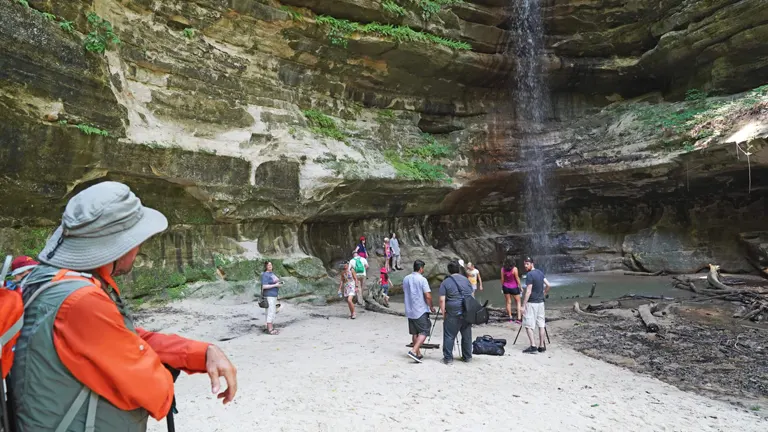
For those seeking a more in-depth understanding of the park’s natural and cultural history, Starved Rock offers guided programs and interpretive hikes. Led by knowledgeable park rangers, these educational experiences provide insights into the geological formations, native flora and fauna, and the rich human history that defines the park’s legacy.
8. Photography
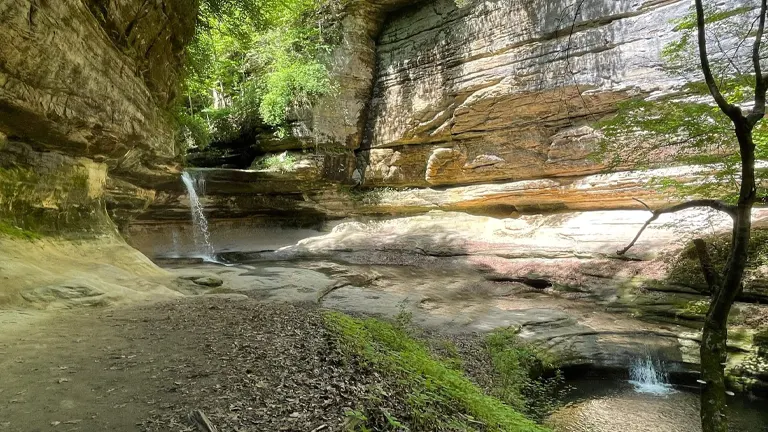
With its breathtaking landscapes, unique geological features, and abundant wildlife, Starved Rock State Park is a paradise for photographers. From capturing the intricate details of frozen waterfalls in winter to framing the vibrant wildflowers in spring, every season offers distinct photographic opportunities, making the park a haven for both amateur and professional photographers.
9. Ice Climbing
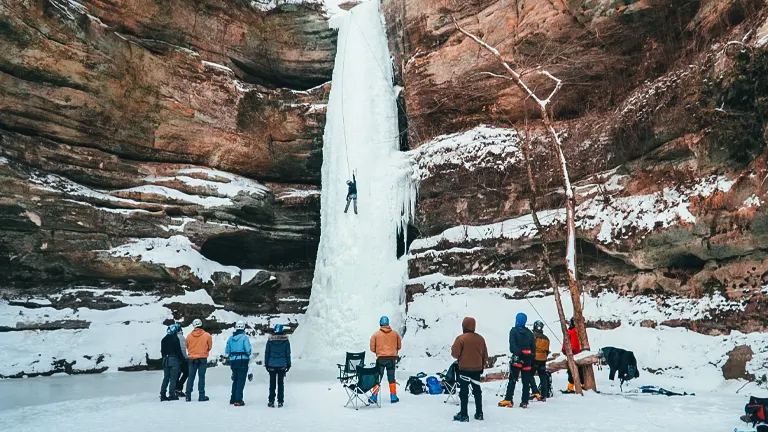
During the winter months, when waterfalls transform into frozen ice falls, adventure seekers can partake in ice climbing activities in select canyons. Starved Rock’s unique topography and frozen cascades provide an exhilarating and challenging experience for enthusiasts of this cold-weather sport, adding an adventurous dimension to winter recreation in the park.
Starved Rock State Park’s array of recreational activities ensures a well-rounded and engaging experience for visitors. Whether exploring the trails, camping under the stars, fishing along the riverbanks, or embracing winter sports, each activity contributes to the park’s allure, inviting nature enthusiasts and adventure seekers alike.
Facilities and Amenities in Starved Rock State Park
- Starved Rock Lodge: Nestled within the park, the historic Starved Rock Lodge stands as a prominent facility, offering a blend of rustic charm and modern comfort. Built by the Civilian Conservation Corps in the 1930s, the lodge features the Great Hall, adorned with intricate woodwork and a colossal stone fireplace. Visitors can enjoy overnight accommodations, dining options, and access to amenities that make the lodge a central hub for those exploring the park.
- Visitor Center: The Visitor Center serves as a gateway to the wonders of Starved Rock State Park, providing essential information and resources for visitors. Inside, interpretive exhibits showcase the park’s geological formations, native flora and fauna, and cultural history. Park rangers offer educational programs, guided hikes, and answer queries, enhancing the overall visitor experience.
- Campsites: Starved Rock State Park accommodates camping enthusiasts with 133 campsites, creating an opportunity for a more extended and immersive stay. Equipped with amenities such as fire pits and picnic tables, the campsites allow visitors to connect with nature while enjoying the comforts of a well-maintained campground. Some sites are available for reservation, ensuring a seamless camping experience within the park’s picturesque surroundings.
- Trail System: A well-developed trail system, spanning over 13 miles, winds through the diverse landscapes of Starved Rock. The trails cater to a range of hiking preferences, from casual strolls to challenging hikes. Signage and trail maps are provided, guiding visitors through the park’s canyons, waterfalls, and scenic viewpoints, creating an accessible and enjoyable outdoor experience.
- Campground Facilities: Beyond the campsites, the park’s campground facilities contribute to a comfortable and enjoyable stay. Modern amenities include restroom and shower facilities, enhancing the camping experience. These facilities cater to the needs of outdoor enthusiasts, allowing them to fully embrace the natural beauty of the park without compromising on essential comforts.
- Winter Sports Areas: Starved Rock State Park embraces the winter season by designating areas for winter sports. Visitors can engage in activities like ice skating, tobogganing, cross-country skiing, and sledding in specified zones, offering a unique and exhilarating way to experience the park’s beauty during the colder months.
- Picnic Areas: Scattered throughout the park, designated picnic areas invite visitors to indulge in outdoor dining amidst the scenic landscapes. Equipped with picnic tables and often strategically placed near captivating viewpoints, these areas provide a perfect setting for families and groups to enjoy meals while surrounded by nature’s beauty.
- Gift Shops: Gift shops within Starved Rock State Park offer a variety of souvenirs, merchandise, and essentials for visitors. From mementos capturing the park’s beauty to practical items for outdoor adventures, the gift shops provide an opportunity for guests to take a piece of the park’s charm home with them.
Starved Rock State Park’s facilities and amenities are thoughtfully designed to enhance the visitor experience, providing a harmonious blend of comfort, education, and recreation. Whether staying at the historic lodge, utilizing camping facilities, or exploring the trails, visitors have access to resources that complement the natural splendor of this Illinois treasure.
Tips for Visiting Starved Rock State Park
- Plan Ahead and Check Conditions: Before embarking on a visit to Starved Rock State Park, it’s crucial to plan ahead. Check the park’s official website or contact the Visitor Center for the latest information on trail conditions, weather forecasts, and any potential closures or special events. This ensures a smooth and well-prepared visit, especially during changing seasons.
- Choose Appropriate Footwear: Given the varied terrain and potential for uneven surfaces, selecting appropriate footwear is key. Whether planning a stroll or a more challenging hike, comfortable and sturdy shoes with good traction are essential for navigating the trails and enjoying the park’s diverse landscapes safely.
- Pack Essentials: Be sure to pack essentials for a day of exploration. This includes water to stay hydrated, snacks, sunscreen, and insect repellent. Carrying a map or using a navigation app can also be helpful, ensuring you stay on the designated trails and don’t miss key points of interest within the park.
- Respect Wildlife and Stay on Trails: Starved Rock is home to diverse wildlife, and it’s crucial to respect their natural habitats. Stay on designated trails to minimize impact on the ecosystem, and observe wildlife from a distance. Avoid feeding animals, as it disrupts their natural behaviors and can be harmful to their health.
- Visit During Off-Peak Hours: To experience the park with fewer crowds and enhance the overall tranquility, consider visiting during off-peak hours. Early mornings or weekdays often provide a more serene environment, allowing you to fully appreciate the beauty of Starved Rock without the hustle and bustle.
- Capture the Moment Responsibly: Starved Rock offers breathtaking scenery, making it a popular spot for photography. If capturing memories, do so responsibly. Avoid disturbing wildlife for a photo and be mindful of other visitors. Follow any posted guidelines regarding photography, especially in sensitive areas.
- Check for Guided Tours and Programs: Enhance your visit by checking for guided tours or interpretive programs offered by the park. Knowledgeable rangers lead hikes, share insights into the park’s history and ecology, and provide a deeper understanding of the natural wonders that make Starved Rock special. Participating in these programs can offer a more enriching experience.
- Adhere to Leave No Trace Principles: Follow the principles of Leave No Trace to minimize your impact on the environment. Carry out all trash, stay on designated paths, and avoid disturbing plants and wildlife. Practicing responsible outdoor ethics ensures the preservation of Starved Rock State Park for future generations.
- Be Weather Aware: Given the park’s seasonal changes and potential weather variations, it’s essential to be weather aware. Dress appropriately for the conditions, whether it’s protecting against sun exposure, layering up for cooler temperatures, or having rain gear on hand. This ensures a comfortable and enjoyable visit, regardless of the weather.
- Respect Park Regulations: Familiarize yourself with and adhere to park regulations. These may include designated pet-friendly areas, trail usage guidelines, and any specific rules regarding activities such as fishing or camping. Respecting these regulations helps maintain the integrity of the park and ensures a positive experience for all visitors.
By incorporating these tips into your visit to Starved Rock State Park, you can make the most of your time in this natural haven, appreciating its beauty while preserving its ecological balance and cultural heritage.
Recommendation
I strongly recommend exploring Starved Rock State Park for a captivating blend of natural beauty and historical significance. This park, renowned for its diverse ecosystems, iconic landmarks, and recreational opportunities, offers a unique and immersive experience. Engage in reflective outdoor activities such as hiking and wildlife observation, actively contributing to ongoing conservation efforts. The scenic trails, historic sites, and collaborative conservation initiatives establish Starved Rock State Park as a central destination for those seeking a harmonious combination of nature and recreational exploration.
Conclusion
In conclusion, Starved Rock State Park stands as a true gem, weaving together geological wonders, rich history, and diverse ecosystems to offer visitors an unforgettable journey into nature. Its towering sandstone formations, lush canyons, and cascading waterfalls provide a breathtaking backdrop for exploration, while the park’s cultural legacy, from Native American history to its role as a vacation resort, adds layers of intrigue. Whether embarking on scenic hikes, participating in guided programs, or simply relishing the tranquility of its landscapes, Starved Rock invites individuals to connect with the outdoors in a way that is both enriching and rejuvenating. As a testament to its significance, the park not only preserves the natural heritage of Illinois but also serves as a haven for wildlife and a hub for outdoor enthusiasts, embodying the harmonious coexistence of conservation and recreation. Starved Rock State Park stands not just as a destination but as a living testament to the beauty and resilience of the natural world, beckoning all to explore its wonders and forge their own connections with this captivating Illinois treasure.
FAQs
- What is the origin of Starved Rock’s name, and is there a historical story behind it?
Starved Rock got its name from a local legend involving a Native American tribe besieged on the rock until they starved. Historically, this account is not fully substantiated, but it remains a captivating part of the park’s lore. - Are there any specific precautions for wildlife encounters while hiking in the park?
While wildlife encounters are common, it’s essential to observe from a safe distance. Avoid feeding animals, maintain a respectful distance, and appreciate the diverse fauna without disrupting their natural behaviors. - Can visitors engage in winter activities at Starved Rock, and what unique experiences does the park offer during the colder months?
Absolutely! Winter brings a magical transformation to the park, with opportunities for ice climbing, witnessing frozen waterfalls, and even spotting bald eagles along the Illinois River. However, it’s important to check for any seasonal restrictions or trail closures. - What conservation initiatives are in place at Starved Rock, and how can visitors contribute to preserving the park’s natural beauty?
The park actively engages in conservation efforts. Visitors can contribute by following Leave No Trace principles, participating in guided programs, and supporting the park’s initiatives. Volunteering for organized clean-up events is also a meaningful way to give back. - Are there any restrictions on camping, and how can one secure a campsite reservation?
Camping is permitted at Starved Rock State Park, with 133 campsites available. Reservations can be made for specific sites, and it’s advisable to check the official park website for details on availability, regulations, and the reservation process. - What unique geological features can be explored within the park, and are there guided tours available to understand them better?
Starved Rock is known for its sandstone formations, canyons, and waterfalls. Guided tours led by knowledgeable rangers provide insights into the geological wonders, enhancing the visitor’s understanding of the park’s natural history. - Are pets allowed in Starved Rock State Park, and are there designated areas for pet-friendly activities?
Pets are allowed in specific areas of the park. Visitors should adhere to leash regulations and utilize pet-friendly trails. Information on pet-friendly zones can be obtained from the Visitor Center or the park’s official website. - How can visitors stay updated on events, trail conditions, and any park-related news before planning their visit?
The park’s official website and Visitor Center are valuable resources for staying informed. Regularly checking for updates on events, trail conditions, and park announcements ensures that visitors have the latest information for a well-prepared and enjoyable experience.
In closing, Starved Rock State Park stands as a year-round retreat, weaving together ancient legends, captivating canyons, and diverse trails. Whether you’re drawn to its rich history or the soothing sounds of waterfalls, this natural haven in the heart of Illinois offers a timeless escape, inviting all to embrace the simplicity and tranquility of the great outdoors.


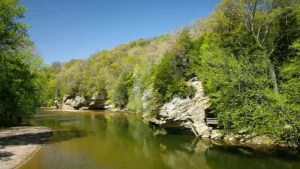
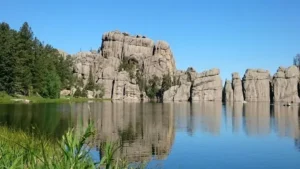
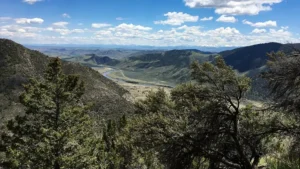
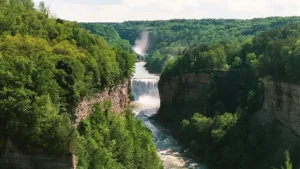




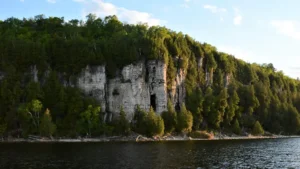
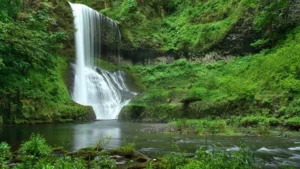
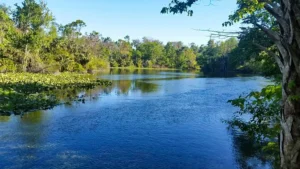
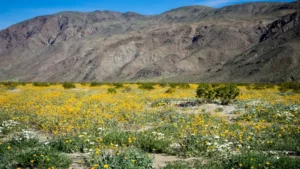
Leave your comment